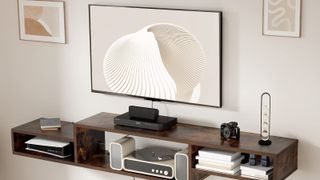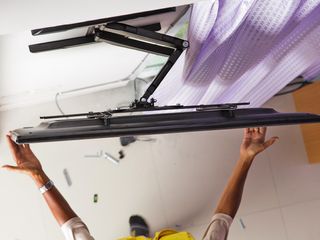Mounting your TV: Best viewing angle and height
Find out the ideal viewing angle and height to get the best television viewing experience.

Ask 20 people how they put their TV on the wall and you’ll probably get 20 answers. But what’s the ideal viewing angle and height to get the most immersive television viewing experience? And what are best TV mounts to use?
Those questions, we can answer.
While there's not an exact science behind where to mount a TV, there are a number of factors you can consider to narrow down the best spot. Place it too high, and you'll need to crane your neck to see anything. Mount it too far off-axis and you'll have your neck turned for the entire duration of a film.
The truth is, it’s a combination of personal preference and trial and error.
TV mounting: Quick tips
- Orient you mounting to the center of the TV. The middle third of the TV screen is where most of your focus will be regardless of what you're watching, so make sure this middle section is at a comfortable eye level.
- How centered is your TV mount? Some TVs have VESA mounting holes in the center of the TV chassis, others on the bottom section. Knowing which your TV uses will change how you position the mounting hardware on the wall.
- Mark your positions. Using a pencil or erasable marker, make small marks to the right and left of the TV, noting where the center of the TV screen should be. Then, determine where the wall mount should attach to set the TV at this same level.
- Consider the weight of the TV. You may need to screw into the wall studs to get the necessary support. A heavy TV will pull screws out of regular drywall, and can lead to a broken TV.
- Use the right hardware. Whether you want to keep your TV flat against the wall, cant it at an angle, or want the flexibility of an articulated stand, you'll find it all on our list of the best TV mounts.
Mounting your TV: Viewing height
If you haven’t checked out the proper screen size and viewing distance for your home, be sure to do that first.
Now let’s concentrate on the ideal height. We stress “ideal” here because not every home has ideal mounting options, as we’ll cover below.
Most action on a TV happens in the center third of the screen--so that’s the part of the screen you’d ideally have at eye level.
The most ergonomic view is to have the middle of the TV screen at eye level, according to Geek Squad installer Brandi Jorgensen. But in most cases where there are multiple people watching TV, it isn’t practical (or fair) to have the screen height to one set of eyes only. Because of this, you want to consider a comfortable range for the entire gang.
Sign up to get the BEST of Tom’s Guide direct to your inbox.
Upgrade your life with a daily dose of the biggest tech news, lifestyle hacks and our curated analysis. Be the first to know about cutting-edge gadgets and the hottest deals.
MORE: Best 4K TVs - Ultra High Definition (UHD) Televisions
There are several factors that go into “eye-level,” of course: your height, the height of your seat cushion, the distance of the screen from your seat and the height of your TV screen. A math formula would make you crazy, so conducting your own research will do the trick. Grab a measuring tape and measure your eye height from the floor. Say it’s 40 inches.
Most action on a TV happens in the center third of the screen—so that’s the part of the screen you’d ideally have at eye level. If the height of your TV is 30 inches, the middle 10 inches are what you're generally fixated on. This is approximately 10 inches from the bottom edge of your screen, depending on how much plastic “framing” is around the visible screen.

A quick calculation tells you the base of your TV (and table top of your TV stand) should be around 25 inches from the floor. This gives you a comfortable viewing range of 35-45 inches high and the center of the screen right at your 40-inch eye level.
The only true test for comfort is trial and error, says Jorgensen. She first recommends recruiting at least two strong friends to help you out. Then, just sit in your favorite spot while your friends start low and incrementally (and manually) raise the TV until it feels right to you. Sure, you can follow any number of formulas, but at the end of the day, you just need to be comfortable looking at a screen for hours at a time (with popcorn breaks, of course). Once you’ve got it figured out, mark the wall and calculate your mounting from there (see below for tips).
Remember, you’re looking for a comfort range, not exact fractions of inches. The ideal height for wall-mounting is the same, but doing a couple of measurements will make the actually TV hanging bit easier.

Mounting your TV: Viewing angle
When it comes to horizontal angles, of course, having the TV screen perpendicular to your eyeballs is perfect. But Jorgensen says the newer TVs have such clarity, wide viewing angles and refresh rate, that the “sweet spot” isn’t entirely necessary to enjoy your television. She says that having the screen at +/ 25 degrees horizontally is perfectly acceptable. She stresses that comfort and the reduction of glare are more important than the measure of the angle itself.
MORE: TV Buying Guide: 11 Things You Need to Know
Mounting your TV: Fireplace no-no
One universally bad idea when mounting your TV is to put it above a fireplace—active or otherwise. The electronics inside a TV are sensitive and could be destroyed by the intense heat generated by the fire, and the occasional smoke and soot that escapes and rises straight into the TV.
Second, the viewing angle for a screen mounted that is uncomfortably high. The reason the front row of the movie theater is empty is because you get a stiff neck after looking up for prolonged periods of time.
The fireplace height is similar in that it’s an unnatural angle to cock your head. The ideal viewing angle is to have the middle of your screen at eye level. But sometimes you have no choice; the shape of the room, orientation of the furniture and TV usage habits may dictate mounting it above an inactive fireplace.
Just remember, in this case, you’re going to want to use an adjustable mounting bracket that tilts forward significantly so that you’re not grabbing your neck for three hours during The Godfather (the original, of course). You’re not ever going to get the perfect angle, you just need to tilt the screen until it’s flat-facing your viewing position--and feels right.
- Best Soundbars - Better TV Sound in a Small Package
- Cable TV Alternatives - A Guide to Cutting the Cord
- Best Streaming Devices: Chromecast, Roku, Apple TV & More
